
Elkridge is an unincorporated community and census-designated place (CDP) in Howard County, Maryland, United States. The population was 15,593 at the 2010 census. Founded early in the 18th century, Elkridge is adjacent to two other counties, Anne Arundel and Baltimore.

Burleigh, or Burleigh Manor, or Hammonds Inheritance is a historic home located at Ellicott City, Howard County, Maryland, built on a 2,300-acre (930 ha) estate. Which included "Hammonds Inheritance" patented in 1796. It is a Federal-style brick dwelling built between 1797 and 1810, laid in Flemish bond. Based on the 1798 Tax assessment of the Elkridge Hundred, the original manor house started as a one-story frame building 24 by 18 foot in size. Also on the landscaped grounds are a 1720 stone smokehouse; a much-altered log, stone, and frame "gatehouse" or "cottage," built in 1820 as a workhouse for slaves and another log outbuilding, as well as an early-20th century bathhouse, 1941 swimming pool, and tennis court. Portions of the estate once included the old Annapolis Road which served the property until the construction of Centennial Lane to connect Clarksville to Ellicott City in 1876. The manor was built by Colonel Rezin Hammond (1745–1809), using the same craftsmen as his brother Mathias Hammond's Hammond–Harwood House in Annapolis. Rezin and his brother Matthias were active in the colonial revolution with notable participation in the burning of the Peggy Stewart (ship). Hammond bequeathed the manor and 4,500 acres (1,800 ha) to his grandnephew Denton Hammond (1785–1813) and his wife Sara who lived there until her death in 1832. All slave labor were offered manumission upon Rezin Hammonds death in 1809, with extra provisions for tools, land and livestock for thirty two slaves. The estate was owned by Civil War veteran Colonel Mathias until his death where he was buried alongside other family members on the estate. His wife Clara Stockdale Hammond maintained ownership afterward. In 1914 the estate was owned by Mary Hanson Hammond with land totaling over 1,000 acres (400 ha) including the outbuildings and slave quarters. In 1935 the Estate was subdivided to 600 acres (240 ha) and purchased by Charles McAlpin Pyle, Grandson of industrialist David Hunter McAlpin. The manor house was renovated with the great kitchen replaced by a "Stirrup Room" where meetings of the Howard County Hunt Club were performed. The house was sold in 1941 to Mrs. Anthony J. Drexel Biddle, Jr. for use of Prince Alexandre Hohenlohoe of Poland during WWII. St. Timothy's School bought the property after the war in 1946, but abandoned plans and sold to Mrs G. Dudley Iverson IV in 1950. The brick was once painted yellow, but by 1956, had almost returned to exposed red brick. As of 2013, it has operated as a livestock shelter.

Dorsey Hall is a historic home in Columbia, Maryland, United States. It is a six-by-one-bay, 2+1⁄2-story stucco structure with a gable roof covered with asphalt shingles. It is a well-preserved and detailed example of the vernacular dwellings of the early 19th century in Howard County and associated with the Dorsey family, one of the "first families" of the county.

Woodlawn, is a historic slave plantation located at Columbia, Howard County, Maryland. It is a two-story, stuccoed stone house built in 1840 with wood frame portions constructed about 1785. It was part of a 200-acre farm divided from larger parcels patented by the Dorsey family. The design reflects the transition between the Greek Revival and Italianate architecture styles. The home is associated with Henry Howard Owings, a prominent Howard County landowner and farmer, who also served as a judge of the Orphan's Court for Howard County. Owings purchased the property in 1858 and died at Woodlawn in 1869. The former tobacco farm produced corn, oats, hay, and pork. The majority of the property surrounding Woodland and its slave quarters were subdivided by 1966 and purchased by Howard Research and Development for the planned community development Columbia, Maryland, leaving only 5 acres surrounded by multiple lots intended for development of an Oakland Ridge industrial center and equestrian center. The summer kitchen, smokehouse, corn crib and stable built about 1830 have been replaced by a parking lot.

White Hall is a historic home located at Ellicott City, Howard County, Maryland, United States. It consists of three sections: the east wing, dating from the early 19th century, the center section, and the west wing. In 1890 the house was partially destroyed by fire and rebuilt in 1900. Three outbuildings remain on the White Hall property: a small square frame workshop; a smokehouse-privy; and springhouse.
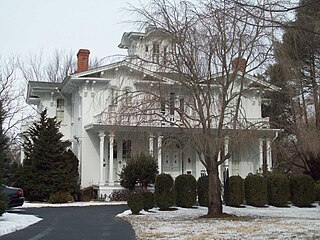
Temora, is a historic home located at Ellicott City, Howard County, Maryland. It is a T-shaped, two-story and cupola, Tuscan-style Victorian house of stuccoed tongue-and-groove boards. The house was built in 1857 after a design prepared by Nathan G. Starkweather, a little-known but accomplished architect from Oxford, England, who also designed the First Presbyterian Church and Manse at West Madison Street and Park Avenue in the Mount Vernon-Belvedere neighborhood in Baltimore, Maryland, with his later more famous assistant - Edmund G. Lind. The house was built for Dr. Arthur Pue Jr. on land given from his grandmother Mary Dorsey Pue of Belmont Estate. The name of the estate Temora comes from the poems of Ossian

Waverly Mansion is a historic home located at Marriottsville in Howard County, Maryland, USA. It was built circa 1756, and is a 2+1⁄2-story Federal style stone house, covered with stucco, with a hyphen and addition that date to circa 1811. Also on the property are a small 1+1⁄2-story stone overseer's cottage and a 2-story frame-and-stone barn, and the ruins of a log slave quarter.

The Elkridge Furnace Complex is a historic iron works located on approximately 16 acres (6.5 ha) at Elkridge, Howard County, Maryland.
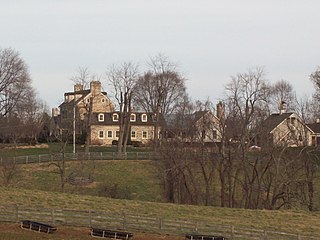
Stone Hall is a historic home located at Cockeysville, Baltimore County, Maryland, United States. It is a manor house set on a 248-acre (1.00 km2) estate that was originally part of a 4,200-acre (17 km2) tract called Nicholson's Manor. It was patented by William Nicholson of Kent County, Maryland in 1719. The property in what is now known as the Worthington Valley was split up in 1754 and sold in 1050-acre lots to Roger Boyce, Corbin Lee, Brian Philpot, and Thinsey Johns.

Round About Hills or Peacefields is a historic slave plantation home located at Glenwood, Howard County, Maryland. An alternate address for this house is 14581 McClintock Drive, Glenwood, Maryland. It was built about 1773 on a 266-acre land patent and consists of a 1+1⁄2-story frame house with a stone end. Thomas Beale Dorsey inherited the property in 1794 then exchanged his interest in the plantation with Thomas Cook's stagecoach wayside town Cooksville.

Charles E. Miller (1902–1979) was an American politician and businessman in Howard County, Maryland
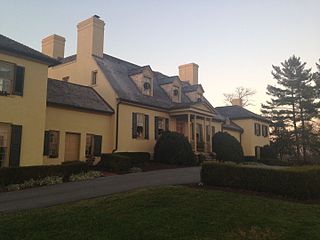
The Belmont Estate, now Belmont Manor and Historic Park, is a former forced-labor farm located at Elkridge, Howard County, Maryland, United States. Founded in the 1730s and known in the Colonial period as "Moore's Morning Choice", it was one of the earliest forced-labor farms in Howard County, Maryland. Its 1738 plantation house is one of the finest examples of Colonial Georgian architectural style in Maryland.
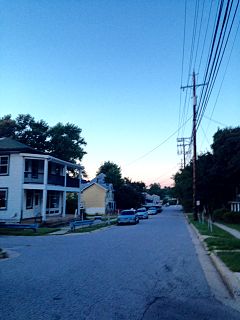
Elkridge Landing was a Patapsco River seaport in Maryland, and is now part of Elkridge, Maryland. The historic Elkridge Furnace Inn site resides within the Patapsco Valley State Park.

Howard Lodge is a historic plantation house in north-central Howard County, Maryland. The main house, built around 1750 by Edward Dorsey, son of John Dorsey, is one of the oldest plantation houses in the county. Compared to other houses of the period, the two-story brick and stone structure is larger and its interior finishes better preserved. The surviving plantation property, about 15 acres (6.1 ha), also includes early 19th-century stone outbuildings. Edward Dorsey was given ownership of seven African-American slaves by his father John Dorsey.
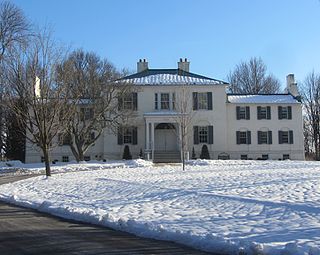
Oakland or Oakland Manor is a Federal style stone manor house commissioned in 1810 by Charles Sterrett Ridgely in the Howard District of Anne Arundel County Maryland. The lands that became Oakland Manor were patented by John Dorsey as "Dorsey's Adventure" in 1688 which was willed to his grandson Edward Dorsey. In 1785, Luther Martin purchased properties named "Dorsey's Adventure", "Dorsey's Inheritance", "Good for Little", "Chew's Vineyard", and "Adam the First" to make the 2300 acre "Luther Martin's Elkridge Farm".
Montpelier Mansion, sometimes referred to as "Montpelier I", was a house in western Laurel, Maryland, now more closely associated with Fulton, Maryland within Howard County, Maryland, United States. The Georgian style building was built circa 1740 and demolished following a 1994 historic survey with addendum and photos dating as late as August 1995.
Marshalee Plantation, sometimes spelled as "Marshallee" or referred to as "Lyndwood" or "Markham", was a plantation located in Elkridge, Maryland in Howard County, Maryland, United States.

Bethesda is located in Ellicott City, Maryland within Howard County, Maryland, United States. The home is sometimes mistakenly referred to as "Dower House" because a small dower house exists on the property. A "dower" is a widow's share for life of her husband's estate, so a dower house is where a widowed mother would live when her son and his family inherited and moved into the main house.
Woodlawn or Papillon was manor home in Ellicott City, Howard County, Maryland in the United States.
Troy Park is a regional park comprising 101 acres in Elkridge, Maryland. The park is located at 6500 Mansion Lane off Washington Boulevard, near the intersection of Maryland Route 100 and I-95.




















